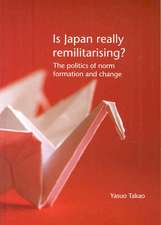The Mexican Aristocracy: An Expressive Ethnography, 1910–2000
Autor Hugo G. Nutinien Limba Engleză Paperback – iul 2004
This expressive ethnography describes the transformation of the Mexican aristocracy from the onset of the Mexican Revolution of 1910, when the aristocracy was unquestionably Mexico's highest-ranking social class, until the end of the twentieth century, when it had almost ceased to function as a superordinate social group. Drawing on extensive interviews with group members, Nutini maps out the expressive aspects of aristocratic culture in such areas as perceptions of class and race, city and country living, education and professional occupations, political participation, religion, kinship, marriage and divorce, and social ranking. His findings explain why social elites persist even when they have lost their status as ruling and political classes and also illuminate the relationship between the aristocracy and Mexico's new political and economic plutocracy.
Preț: 304.84 lei
Nou
Puncte Express: 457
Preț estimativ în valută:
58.33€ • 61.18$ • 48.56£
58.33€ • 61.18$ • 48.56£
Carte tipărită la comandă
Livrare economică 01-15 aprilie
Preluare comenzi: 021 569.72.76
Specificații
ISBN-13: 9780292719514
ISBN-10: 0292719515
Pagini: 398
Ilustrații: 7 b&w, 20 ld, 1 map, 2 tables
Dimensiuni: 152 x 229 x 26 mm
Greutate: 0.59 kg
Editura: University of Texas Press
Colecția University of Texas Press
Locul publicării:United States
ISBN-10: 0292719515
Pagini: 398
Ilustrații: 7 b&w, 20 ld, 1 map, 2 tables
Dimensiuni: 152 x 229 x 26 mm
Greutate: 0.59 kg
Editura: University of Texas Press
Colecția University of Texas Press
Locul publicării:United States
Notă biografică
Hugo G. Nutini is University Professor in the Department of Anthropology at the University of Pittsburgh.
Cuprins
- Preface
- Introduction
- Chapter 1. Demographic Composition and Contextual Definition of the Aristocracy
- Chapter 2. The Relationship of Class and Ethnicity: Somatic and Racial Considerations
- Chapter 3. The Realization of Expression in the Ethnographic Context
- Chapter 4. The Organization of Urban Living: Settlement, Residence, and the Household
- Chapter 5. Economy, Material Culture, and Political Participation
- Chapter 6. Religion: Ideology, Worship, and the Ritual-Ceremonial Complex
- Chapter 7. Social Organization: The Configuration and Interrelationship of Kinship Units and Institutions
- Chapter 8. Internal Stratification and Organization of the Group
- Conclusions
- Notes
- Glossaries
- Bibliography
Recenzii
Providing ample details about the Mexican aristocracy, Nutini raises intriguing questions about the nature of social class by highlighting the aristocracy's shifting place within Mexico's superordinate social stratum.
Descriere
This ethnography describes the transformation of the Mexican aristocracy from the onset of the Mexican Revolution of 1910, when the aristocracy was unquestionably Mexico’s highest-ranking social class, until the end of the twentieth century, when it had













